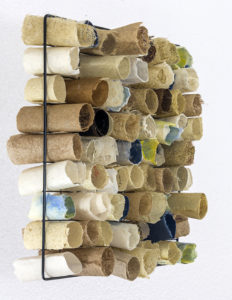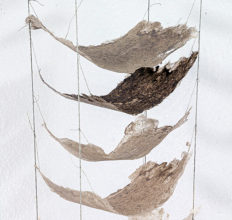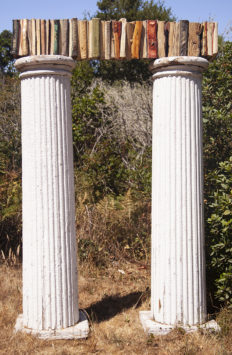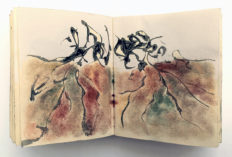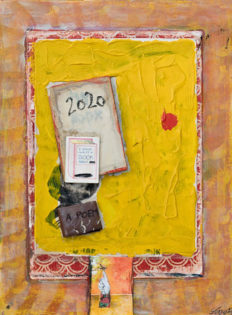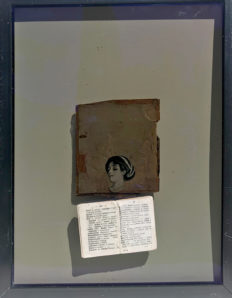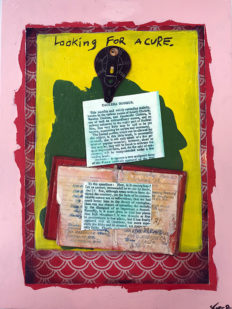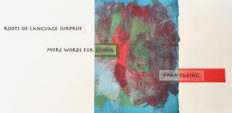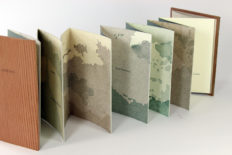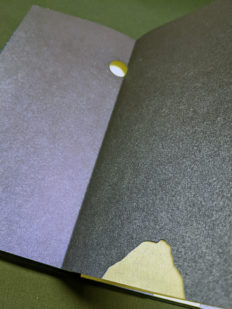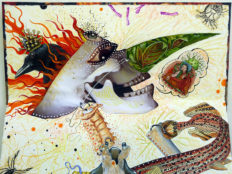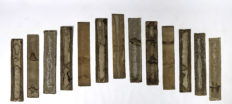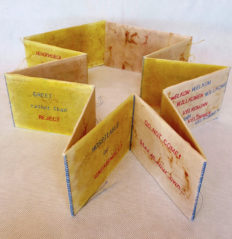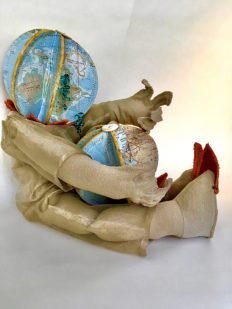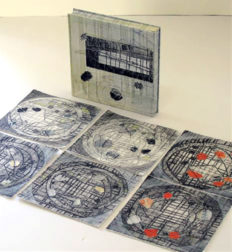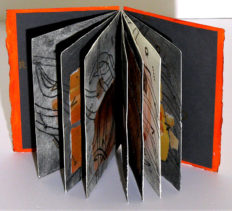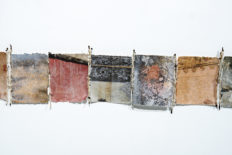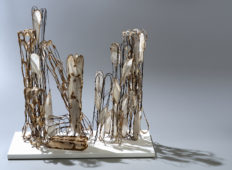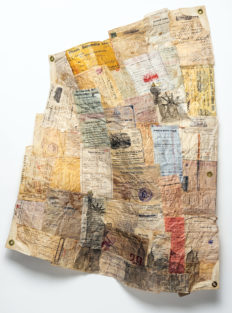Falling Open: On & Off the Page, Book Art and Book-Related Objects Curated by Renée Owen. Exhibiting Artists: Jane Ingram Allen, Rhiannon Alpers, Pamela Blotner, Lyn Dillin, Kathleen Edwards, Paula Gray & Susan Gross, Timothy Graveson, Mirka Knaster, Rachel Laufer, Sherrie Lovler, Linda MacDonald, Teddy Milder, Renee Owen, Cheryl Pfeil, Louise Pryor, Inez Storer, Jami Taback, Susan Zimmerman.
Artist Statement
Artist Statement
More by this Artist
In the spirit of the Japanese aesthetic of “mono no aware,” a gentle loving towards all that is doomed.
Then: A fragment of a long-ago black & white photo, of a little brown-haired girl with a shy smile, kneeling in a backyard sandbox – a container to shelter her from harm. She escapes often, to the quiet woods behind her house, where she collects bones & sticks & feathers, fodder for her imaginative adventures.
Now: There is nowhere to escape to, as a viral pandemic races around the globe and wildfires ravage the drought-stricken land. An endless time of between, of lock downs, and air too smokey to breathe. A time for art making and poetry writing and frozen zooms, where we move like masked marauders, going nowhere. The concept of time, floating yet frenzied, filled with preoccupations of wiping and sanitizing and fearing each other’s touch. And a fine layer of white ash drifts from the darkened sky, blanketing everything in sorrow.
Materials: Wood, watercolor paper, deconstructed book parts, vintage Asian box parts, sumi ink, gouache, acrylic, old photograph fragment, waxed linen thread, metal insulation support rods, old saki bottle stopper, bamboo, repurposed curtain finials, woven shoelaces, rusty washer, old postage stamps, bookcloth and Eleanor’s ephemera.
Techniques: Gestural calligraphy, collage, assemblage, embroidery, knotting, painting, dyeing, artist’s poetry, and original accordion binding.
Year Completed: 2020.
More by this artist
Artist Statement
“Albatross” addresses our global environmental crisis and the growing number of species vanishing on our planet. Birds, which have been referred to as “Windows to Heaven,” have been particularly affected.
“Albatross” refers to the “Rime of the Ancient Mariner,” a poem by Samuel Taylor Coleridge, in which a sailor shoots and kills an albatross, symbol of good luck. His action results in the destruction of the ship and the death of his fellow sailors, while he remains alive,doomed to tell the tale to anyone who will listen for rest of his life.
Artist Statement
Artist Statement
Language relics reveal how past civilizations thought about their relationship with the environment and suggest how changes in language may have changed the relationship over time.
I explore my curiosities with paper and ink, my conjuring partners, that combine in unexpected ways, offering fresh vision and pleasure.
Artist Statement
More by this artist
More by this artist
More by this artist
I am intrigued by tension generated between hard and soft surfaces; both can be fragile or strong. Through tension, I explore inequality, shifting spaces between ancient/contemporary, creation/destruction, non-violence/aggression. In these Covid-threatening, turbulent political times, I use art to soften tension and isolation.
“wall constructions” and “border relics” were inspired by artist residencies in Oaxaca, Mexico. Arriving just after 2016 Presidential election, threats of building border walls loomed large, becoming the focus of my work. Often built when feeling unsafe, walls can manifest desire to isolate, divide, defend-making it hard to “see” who is on the other side. We now live in imposed isolation with literal and metaphorical walls.
Photographing, I found comfort in Oaxacan ancient-contemporary walls. No longer only physical barriers, they became a state of mind, elements of support, surfaces for art, communication, protest. “wall constructions” are images of Oaxacan walls printed on handmade paper, linked by paper-wrapped barbed wire spanning 17 feet. Stitched enhancements intertwine my handwork to symbolically and delicately mend US border/refugee policies. border relics were inspired by rows of pipe-organ cactus in the Ethno-Botanical Garden. I built cactus structures that reference a porous passageway and relics of those who didn’t make it across the border.
More by this artist
Steamship Ticket to America #2 This piece uses historically accurate steamship tickets circa early 1900s, many of them steerage class, to honor the memory of my grandmother who, at age 17, stole a steerage-class steamship ticket to America off the kitchen table and ran off to America from Eastern Europe. This piece is dedicated to all immigrants who made that long ocean journey to America and to all immigrants today from all countries who wish to make American their home.

